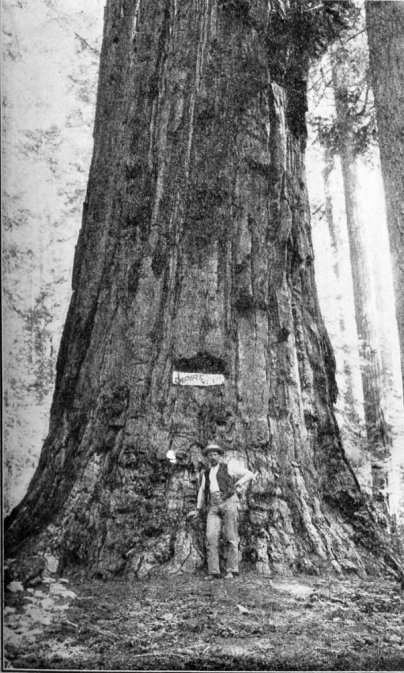
EMPIRE STATE TREE.
Calaveras Grove.
| Online Library: | Title | Author | California | Geology | History | Indians | Muir | Mountaineering | Nature | Management |
Yosemite > Library > Big Trees of Calif. > Habits and Characteristics >
Next: Cones • Contents • Previous: Age
The Big Tree is an evergreen, and is the largest and scarcest of all forest trees. Its foliage is very short, about one-fourth of an inch in length, ovate-acuminate in form, and scale-like, adhering closely to the small branchlets. In young trees the leaves are about half an inch in length very narrow and sharp-pointed, linear-lanceolate, lying closely to the slender twigs, pointing forward.
In young trees, during their first two or three centuries of life, the tapering body is thickly covered with slender branches, which are erect and aspiring above, to catch the electric ether from the atmosphere, which is one of their most vital sources of life; horizontal near the middle of the tree, and drooping below, from the heavy weight of winter snows and lack of nourishment. As the tree enlarges in size the lower branches die and fall away, leaving the body of the tree bare for one hundred feet or more up.
The tops of the younger medium-sized trees develop into a graceful dome form in outline,

EMPIRE STATE TREE. Calaveras Grove. |
Throughout all the different groves, the Sequoias seem to have naturally arranged themselves into family groups and social clusters, selecting choice localities where the soil is most suitable and well supplied with their favorite condition of moisture, of which they require a much greater quantity than the large pine and other forest trees. Their majestic, graceful beauty is unequalled. Since their discovery they have become one of the great wonders of the world. The bright cinnamon color of their immense fluted trunks, in strong contrast to the green foliage and dark hues of the surrounding forest, makes them all the more conspicuous and impressive. In their sublime presence a person is apt to be filled with a sense of awe and veneration, as if treading on hallowed ground.
In the growth of the tree there is an annual inside new thin growth of bark formed in contact with the new outside annual ring growth of wood. The parting of the old outside bark into ridges is caused by the gradual increase in the size of the tree inside the bark.
The color of the bark gradually changes from a dark purple tint to a cinnamon color, and becomes corrugated into narrow vertical ridges. On full grown trees, where well sheltered and protected from fierce storms, these ridges of bark are sometimes found two feet in thickness, in rare instances three feet. The average thickness is probably about fifteen inches, and, where openly exposed to storms, still less.

|
| Photograph by Fiske. |
| FOUR GUARDSMEN, MARIPOSA GROVE. |
Next: Cones • Contents • Previous: Age
| Online Library: | Title | Author | California | Geology | History | Indians | Muir | Mountaineering | Nature | Management |
http://www.yosemite.ca.us/library/big_trees_of_california/characteristics.html